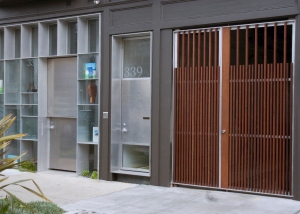This week we were introduced to oxy-acetylene and mig welding. welding jacket and hood required!
the oxy-acetylene tanks and dials require some specific setting up, but provide a super flexible rig for welding… outdoors, indoors, etc. This is also called stick welding since you have to feed the stick material into the weld by hand.

 Here’s Charlie demonstrating the mig welder and the ideal ‘caterpillar’ type of weld one hopes to achieve….
Here’s Charlie demonstrating the mig welder and the ideal ‘caterpillar’ type of weld one hopes to achieve….


since this week was about the tutorial, not production, i am including images of some metalwork project I have done in the past that relate to this course. Last summer, with Greg Kice of Lundberg Design, we fabricated this storefront and lighting and installed it on-site for the Restaurant Out-The-Door on Bush Street in San Francisco.


 Previously, Greg Kice and I collaborated and fabricated an entrance gate for architect David Baker in San Francisco.
Previously, Greg Kice and I collaborated and fabricated an entrance gate for architect David Baker in San Francisco.


 Finally, a conceptual ‘Reading Machine’ I designed and fabricated for a 1st year core studio project at MIT.
Finally, a conceptual ‘Reading Machine’ I designed and fabricated for a 1st year core studio project at MIT.




